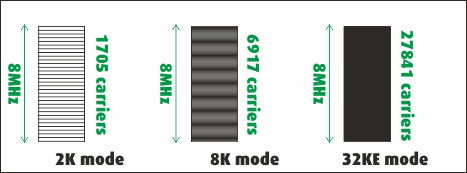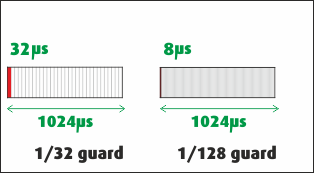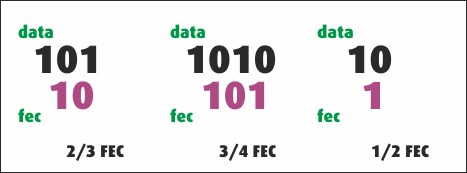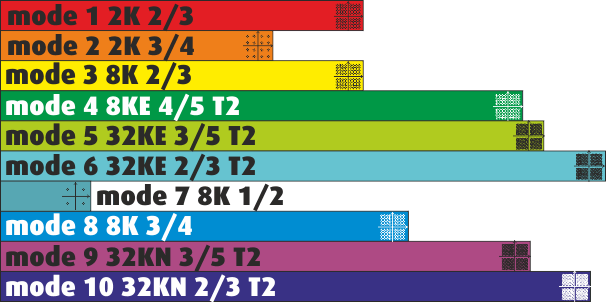Freeview modes - a simplified explanation
 Brian Butterworth published on UK Free TV
Brian Butterworth published on UK Free TV As mentioned in How digital television works Freeview signals can be broadcast in a number of different "modes", which are a combination of five parameters. Some of these have changed over the years because the increase in computing power has made more efficient methods of broadcasting cheap enough to fit in a set-top box - it is now possible to broadcast high definition television or more standard definition services on the same physical wavelength.
As some of the ideas that are implemented would fill a text book by themselves, I have presented the concepts in a simplified way.
Sub-carriers
Each Freeview multiplex is broadcast within an 8MHz channel that was originally allocated to analogue television. Rather than being a single broadcast, the channel is split into a number of different signals that sit next to each other.The original digital terrestrial broadcasts (from the launch of ONdigital) used 1,705 sub signals (referred to as 2k mode) about 4,600 Hz apart. After switchover 6,817 subcarriers (8k mode) means the signals are 1,170 Hz apart, with the high definition service using 27,841 (32ke) subcarriers just 280Hz apart.

It is possible to space carriers so close together because they are carrying digital information, in the analogue domain the problem with sidebands would render a similar system useless.
Symbol duration
For reasons detailed below, the information is not transmitted in single bits on each carrier, but as groups of bits which are referred to as "symbols". Each symbol is held in the transmission system for a given duration, 1024 us. The longer this time is, the less information is carried, but too short a duration for each symbol would not allow the receiver to detect the information correctly.Guard interval
Each subcarrier also uses a guard interval, which turns off each carrier as part of the transmission cycle. With SD broadcasts, this is 1/32th of the symbol time (32us), on HD it is 1/128th (8us). The guard intervals start each symbol and exist to deal with the problems of multipath - where the signal is being received directly and also by reflections.
Forward error correction
In non-synchronous digital transmission systems, such as those used for the internet, the presence of data corruption between the sender and receiver can be signalled back to the source and the data resent.However, a digital broadcast is a one-to-many unidirectional system, with no ability to ask for data to be resent.
For this reason, the transmissions use "forward error correction", which is a system that allows a certain level of errors to be detected.
The most basic form of a forward error correction (FEC) would be to transmit each bit twice - as long as each bit was sent along a separate subcarrier, then a single bit loss on one carrier could corrected by using the one sent on the other carrier. However, this is very inefficient, as it reduces the useful capacity of the system by half.

So, instead the DVB-T system uses a Punctured Convolution coding system. Instead of sending each bit twice, bits are grouped and then a code that describes the bits in a way that a single bit error can be detected and corrected most of the time.
Quadrature amplitude modulation
In the above descriptions, the word "symbol" was used to describe what is transmitted. You may have thought that a digital system would transmit information on the subcarriers as bits. However, doing this in a broadcast system is actually unproductive.For this reason, quadrature amplitude modulation is used. This takes the incoming bits and encodes them in groups. The most basic form encodes bits two at a time, using sine (Q) and cosine (I) functions that are then added to the main carrier. In effect "00" is encoded as -Q-I, "11" as +Q+I, with "01" and "10" being +Q-I and -Q+I.

At the next level, as used for DVB-T, the bits are encoded in groups of four bits (16QAM) or eight bits (64QAM), with DVB-T2 being groups of 16 bits (256QAM).
UK Freeview modes
There are 10 modes defined for use in the UK, these are:- Mode 1: DVB-T 1705 (2K) carriers, 64QAM mode, FEC=2/3, 1/32 guard = 24.13Mbps
- Mode 2: DVB-T 1705 (2K) carriers, 16QAM mode, FEC=3/4, 1/32 guard = 18.1Mbps
- Mode 3: DVB-T 6817 (8K) carriers, 64QAM mode, FEC=2/3, 1/32 guard = 24.1Mbps
Mode 4: DVB-T2 6913 (8KE) carriers, 64QAM mode, FEC=4/5, 1/32 guard = 34.7MbpsunusedMode 5: DVB-T2 27841 (32KE) carriers, 256QAM mode, FEC=3/5, 1/128 guard = 36.1Mbpsunused- Mode 6: DVB-T2 27841 (32KE) carriers, 256QAM mode, FEC=2/3, 1/128 guard = 40.2Mbps
- Mode 7: DVB-T 6817 (8K) carriers, QSPK mode, FEC=1/2, 1/32 guard = 6.0Mbps
- Mode 8: DVB-T 6817 (8K) carriers, 64QAM mode, FEC=3/4, 1/32 guard = 27.1Mbps
"high capacity commercial multiplex mode". Mode 9: DVB-T2 27265 (32KN) carriers, 256QAM mode, FEC=3/5, 1/128 guard = 35.2Mbpsunused- Mode 10: DVB-T2 27265 (32KN) carriers, 256QAM mode, FEC=2/3, 1/128 guard = 39.2Mbps
- Mode 11: "Northern Ireland mode" details TBC
Diagram showing capacity for each mode:

Help with Television sets?
Monday, 11 September 2017
B
Bob Rowatt5:41 PM
I can't get any signal (Strength 0 quality 100) from C32 from Blackhill transmitter. All other channels have 70+ strength. Any suggestions?
| link to this comment |
Tuesday, 12 September 2017
MikeP
10:37 AM
10:37 AM
Bob Rowatt:
At Blackhill, Channel 32 is used for the COM7 services which are coded using DVB-T2 so you need a Freeview HD receiver to get that as well as COM8 on Channel 35. Do you get Channel 35? Note that an 'HD Ready' television is not capable of receiving DVB-T2 transmissions, only displaying the pictures fed from a separate set top box if that is Freeview HD capable.)
Please give a full post code so we can check whether you location is served by those channels.
| link to this comment |
Thursday, 8 February 2018
R
RogerW12:05 PM
Cardiff
Hi,
Do you think that anyone is still using DTG-2, or any of the other 2K FFT modes?
The Winter Hill ( Which Freeview channels does the Winter Hill transmitter broadcast? ) was the only one I could find on the site.
But Digital UK | Multiplexes lists the G-Man Mux as using 8K FFT now.
Thanks,
Roger.
| link to this comment |
RogerW's: mapR's Freeview map terrainR's terrain plot wavesR's frequency data R's Freeview Detailed Coverage
Friday, 4 May 2018
M
Malcolm Thwaite9:50 PM
I can't access freeview on my Panasonic TX-L32X20B tv
| link to this comment |
M
MikeB10:35 PM
Malcolm Thwaite: If yo were before and now your not, check your system.
| link to this comment |
Friday, 26 October 2018
Hi, are you interested in updates to transmitter frequencies? I have had to painstakingly work out the channels for the Tunbridge Wells transmitter for my raspberry pi/DVB-T2 hat/tvheadend set up and I'm happy to share these to update your website if it is useful?
Cheers
Chris
| link to this comment |
Saturday, 27 October 2018
MikeP
10:46 AM
10:46 AM
Chris Duff:
You could have saved yourself a lot of work by using the Digital UK Coverage Checker, see Digital UK - Coverage checker and putting in your post code and house number. That would have shown you all the transmitters available at your location, given the channels used now and in the future, given the direction to aim your aerial and even what type is needed for each transmitter. It also gives the distance away and the expected reception conditions now and in the future.
This website channel usage information is known to be out-of-date as the owner, who is the only person allowed to update it, is not available and has not been for a few months.
The advice given above has been given on many occasions via these pages.
| link to this comment |
C
Chris Duff1:06 PM
Thanks Mike. The info was on a section you had to expand to read and I didn't spot it - still, it was a good education on the way these things work. Shame you cannot update the details on these webpages.
| link to this comment |
Friday, 9 August 2019
G
Gilbert Wright9:13 AM
I'm very upset about the changes to Caldbeck transmitter on July 31st 2019.
All 6 of the HD channels I can now receive have been moved to UHF Channel 22.
Where I live, I get a much weaker signal than on the other channels and, as a result, I now have no watchable HD channels.
The signal is good when it works, but once every 4 or 5 minutes, it drops out completely for 15-20 seconds. The other channel on this frequency is More4+1, and this does the same.
I am already using a signal booster, and it still happens.
I spoke to two completely useless people on the Freeview helpdesk and got nowhere - one of them said it's nothing to do with signal strength, you must have interference from a mobile mast, but I got the filter they suggested, and that didn't help either.
When i'm updating channels with my recorder box, it reports a signal strength of 4/10 for Channel 22, and 10/10 for all the others.
I don't understand why they have to put the HD channels on this transmitter when there are 50 or so rubbish channels using ones that work.
I paid a lot of money for an HD recorder and a 4K TV, and I can't watch a single channel in HD.
I'm concerned that, when it comes to 6G, there will be so little bandwidth left for TV that the colour will break up, and we'll have to watch in black & white.
Is this really progress?
| link to this comment |
MikeP
9:04 PM
9:04 PM
Gilbert Wright:
I suggest you voice your feelings to Arqiva, who operate the transmitters on behalf of Freeview.
| link to this comment |
Select more comments
Your comment please!